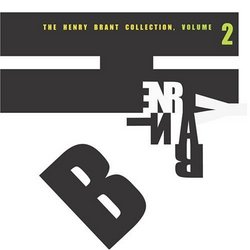| All Artists: OBERLIN WIND ENS/BRANT/K Title: V.2 HENRY BRANT COLLECTION Members Wishing: 0 Total Copies: 0 Label: Innova Original Release Date: 8/31/2004 Release Date: 8/31/2004 Genres: International Music, Jazz, Classical Styles: North America, Chamber Music, Forms & Genres, Concertos, Historical Periods, Classical (c.1770-1830), Modern, 20th, & 21st Century, Instruments, Strings Number of Discs: 1 SwapaCD Credits: 1 UPC: 726708640927 |
Search - OBERLIN WIND ENS/BRANT/K :: V.2 HENRY BRANT COLLECTION
 | OBERLIN WIND ENS/BRANT/K V.2 HENRY BRANT COLLECTION Genres: International Music, Jazz, Classical
|
Larger Image |
CD Details |
CD ReviewsThe outlandishly original voice of Henry Brant Discophage | France | 03/02/2008 (5 out of 5 stars) "I knew the name of Henry Brant - one of the recognized mavericks of American 20th Century music and, now that Nancarrow is dead, possibly the last surviving one - but, other than his "Signs and Alarms" and "Galaxy Two", which I heard long ago on an LP which I have mostly for its pairing, Antheil's Ballet mécanique, I wasn't familiar with his music. But I recently listened to his "Kingdom Come" and "Machinations", recordings from the 1970s first published by the Desto label and reissued on CD by Phoenix, and I was bowled over (see my review of Kingdom Come/Machinations). So I decided to investigate more, and after volume 1 of this 9-volume Henry Brant Collection, which I was equally enthusiastic about (HENRY BRANT COLLECTION V1 (2CD)), this volume two, with its coherent pairing of three Concertos, makes me again jump to the rafters.
Nomads, composed in 1974, is a 17-minute triple concerto for solo voice, solo brass instrument (here a saxophone), solo percussionist and wind-brass ensemble, in which the solo parts are completetely improvised and independent of each other and of the the accompanying ensemble. The accompaniment is written in a fully contemporary language, dissonant, powerful to the point of brutality, rhythmically vigorous, jagged. I suppose the three soloists on the recording, Steven Fallon (voice), Dave Dimmock (sax) and Adam Rudolph (drumset) were closely tutored by Brant: their improvised part is outlandishly noisy, brutal, eructant. It is so far out as to be excrutiatingly funny I find - the closest classical music will ever get to trash rock. But be warned: it is so provocative, it will certainly not be of everybody's taste, and many will even question whether it is music (old story). Still, in our era of watered-down tastes and pandering to the least-demanding, in which commissioning institutions, performing companies and public alike seem to revel in the most insipid neo-tonal music, it has an enduring value. Solar Moth, a 23-minute concerto for violin from 1979, is slightly easier to take, but equally original and inventive. The accompanying ensemble is comprised of four violins, four violas (played here by the soloist himself on an 8-track recording), three flutes, harp, piano, marimba (all played by the composer) and voice (soprano Amy Snyder). It is a festival of eerie sounds, clouds of pizzicatti - the clangy sound and jagged rhythms are sometimes evocative of this other great maverick of 20th Century American music, Conlon Nancarrow -, cat meows, dog yelps, voice sounding like a slide-flute and violin in imitation, voice sounding like a demented cricket and violin in imitation, voice sounding like a wild exotic bird, high-pitched trills, waves of interrogative glissandos, caressed whispers - and there are also some highly lyrical lines. I find it mesmerizingly imaginative and poetic in its sonic invention, and can think of not many precedents (Salvatore Sciarrino's Capricci for solo violin from 1976 fleetingly came to mind, and also Enescu's Impressions d'Enfance for violin and piano, but I doubt the composer even knew these pieces). The liner notes inform us that "because of the long association of the three performers it was possible for the composer to dispense with notational aids, proceeding by verbal instruction alone. Nevertheless, the work was designed and realized with the pitch, time, and timbral controls associated with fully notated music". The downside is that I guess this recording, made in 1983 and first published on LP by 1750 Arch Records (a label famous for its "discovery" of Conlon Nancarrow), is a one-off, closer to popular music (although anybody can pick up and adapt the hits of the Beatles or the Stones, not so here) than to the tradition of notated Western classical music. And we get another Concerto, this time for double bass with two widely separated chamber ensembles and one isolated horn, with Ghosts Nets, the most recent work on this disc, a 24:45-minute composition from 1988. Those "Ghosts Nets" are the drifting remnants of the huge and murderous nets used by the fishing fleets in the North Atlantic that wantonly destroy marine life and seabirds. The relation with the music is not explained. The work isn't as far-fetched and outlandishly original as the two previous ones, but nonetheless it is full of striking gestures, subtle sonic invention, ear-catching orchestral colors, moments of great lyricism, moments of hushed mystery, angular and anguished outbursts, and imaginative interplay between soloist(s) and ensemble, I have yet to meet something even slightly disapointing in my exploration of the music of Henry Brant. Recoding dates are not given - Ghost Nets I know first came out in 1991 on an obscure label with, if the review published in Fanfare back then is to be believed, poor production values -, sound is fine, and TT is 65 minutes. " |

 Track Listings (3) - Disc #1
Track Listings (3) - Disc #1